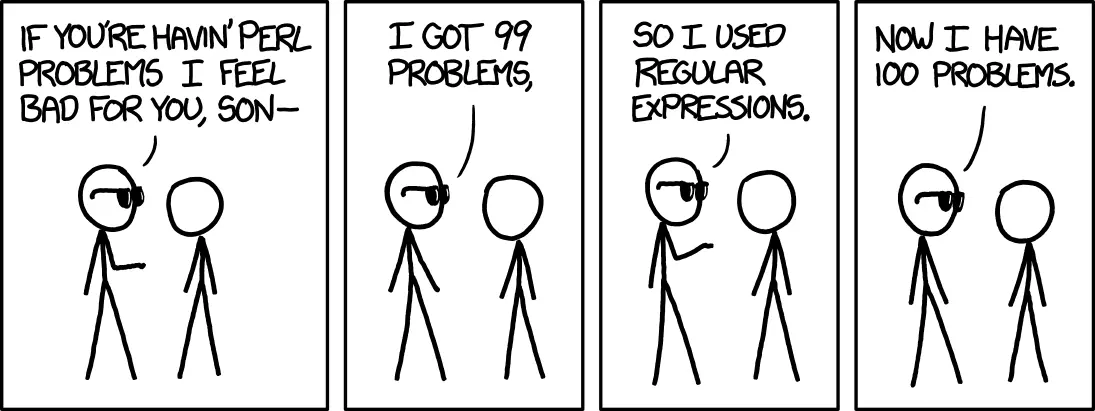^.?$|^(..+?)\1+$
<answer>
Matches strings of any character repeated a non-prime number of times
This is brilliantly disgusting.
Literal interpretation of the regex
The regex matches either a line with a single character or a line with a sequence of two or more characters that’s repeated two or more times. For some examples: the regex matches “a”, “b”, “abab”, “ababab”, “aaaa”, and “bbbbbb”, but does not match “aa”, “bb”, “aaa”, “ab”, “aba”, or “ababa”.
Hint for the special thing it matches
For a line with a single character repeated n times, what does matching (or not matching) this regex say about the number n?
You forgot empty line. Since first part is
^.?$it’s one or zero of any character.
All my homies hate regexs. That’s actually the best use case I found for LLMs so far : I just tell it what I want it to match or not match, and it usually spits out a decent one
Oooof. I feel like trying to figure out what’s wrong with some regex I didn’t write is much harder than writing it myself personally.
That sounds…
Easier to get almost right than actually learning the subject.
Much, much harder to get completely right than actually learning the subject.
So yes, basically the archetypal use case for LLMs.
Syntactically valid Perl
Something like
!“A line with exactly 0 or 1 characters, or a line with a sequence of 1 or 3 or more characters, repeated at least twice”!<
You’re misreading the
..+?part. That means 2 or more characters, non greedy.It’s a line with a sequence of two or more characters repeated at least twice.
The answer given in the spoiler tag is not quite correct!
Test case
According to the spoiler, this shouldn’t match “abab”, but it does.
Corrected regex
This will match what the spoiler says:
^.?$|^((.)\2+?)\1+$Full workup
Any Perl-compatible regex can be parsed into a syntax tree using the Common Lisp package CL-PPCRE. So if you already know Common Lisp, you don’t need to learn regex syntax too!
So let’s put the original regex into CL-PPCRE’s parser. (Note, we have to add a backslash to escape the backslash in the string.) The parser will turn the regex notation into a nice pretty S-expression.
> (cl-ppcre:parse-string "^.?$|^(..+?)\\1+$") (:ALTERNATION (:SEQUENCE :START-ANCHOR (:GREEDY-REPETITION 0 1 :EVERYTHING) :END-ANCHOR) (:SEQUENCE :START-ANCHOR (:REGISTER (:SEQUENCE :EVERYTHING (:NON-GREEDY-REPETITION 1 NIL :EVERYTHING))) (:GREEDY-REPETITION 1 NIL (:BACK-REFERENCE 1)) :END-ANCHOR))At which point we can tell it’s tricky because there’s a capturing register using a non-greedy repetition. (That’s the
\1and the+?in the original.)The top level is an alternation (the
|in the original) and the first branch is pretty simple: it’s just zero or one of any character.The second branch is the fun one. It’s looking for two or more repetitions of the captured group, which is itself two or more characters. So, for instance, “aaaa”, or “ababab”, or “abbabba”, but not “aaaaa” or “abba”.
So strings that this matches will be of non-prime length: zero, one, or a multiple of two numbers 2 or greater.
But it is not true that it matches only “any character repeated a non-prime number of times” because it also matches composite-length sequences formed by repeating a string of different characters, like “abcabc”.
If we actually want what the spoiler says — only non-prime repetitions of a single character — then we need to use a second capturing register inside the first. This gives us:
^.?$|^((.)\2+?)\1+$.Where the
\2refers to the character captured by(.), meaning that it has to be the same character throughout the matched string.Thanks, I now have insight into my own personal hell for when I die.
Regex is good for a few very specific things, and sysadmins used to use it for goddamn everything. If all your server logs are in lightly-structured text files on a small number of servers, being able to improvise regex is damn useful for tracking down server problems. Just write a shell loop that spawns an
sshlogging into each server and runninggrepover the log files, to look for that weird error.These days, if you need to crunch production server logs you probably need to improvise in SQL and
jqand protobufs or systemd assmonkery or something.But if you actually need a parser, for goodness sake use a parser combinator toolkit, don’t roll your own, especially not with regex. Describing your input language in plain Haskell is much nicer than kludging it.
(This is the “totally serious software engineering advice” forum, right?)
I’ve worked mostly as a data scientist / analyst but regex was being user to identify various things in the SQL database (which was viewed locally via R table). I forget the exact is cases, mostly remembering how complex some of it got… Especially after certain people were using GPT to build them.
And GPT like to make up extra bits not necessary, but my coworkers didn’t exactly have the knowledge to read regex, which lead to nobody really checking it. Now it just gives me anxiety, haha.
Average Matt Parker code
I upvoted this because I hate it.
Whatever you do, don’t get in a time machine back to 1998 and become a Unix sysadmin.
I was a sysadmin with some Linux usage in 1998, does that count?
I have to admit that using CL-PPCRE does not really help me understanding the regexp any better. But this may be because I deal with complex regexps for decades now, and I just read them.
I could be wrong but I think the ‘(…+?)’ portion will either remover a dud or replenish the allowance.
Is there a reason to use
(..+?)instead of(.+)?Yes, the first one matches only 2 more characters while the second matches 1 or more. Also the +? is a lazy quantifier so it will consume as little as possible.
Ah, didn’t know +? was lazy, thanks
I thought, the +? was going to be a syntax error. 🙃
I was like, why specify “one or more” and then make it optional? Isn’t that just .*?
The pipe is throwing me off because usually I have to do parentheses for that to work…
A non prime number of times… It looks like the string of characters could repeat number of times because the whole capture group repeats. I don’t see a prime constraint.
The capture group must be the same each time it repeats, so the number of characters stays the same. So X groups of Y characters = string of length X*Y. X and Y can be anything so any string length that can be made by multiplying two numbers-- which is every non-prime string length-- is matched. 0 and 1 are handled specially at the start.
Relevant xkcd:

I’m going to assume the answer is a magic square attempt that just isn’t very good
For a second I thought I was still in the thread about monkeys face-rolling typewriters until the heat death of the universe not eventually producing Hamlet
So, here’s my attempt
The first portion (
^.?$) matches all lines of 0 or 1 characters.The second portion (
^(..+?)\1+$) is more complicated:(..+?)is a capture group that matches the first character in any line, followed by a smallest possible non-zero number of characters such that (2) still matches (note that the minimum length of this match is 2)\1+matches as many as possible (and more than 0) repeats of the (1) group
I think what this does is match any line consisting of a single character with the length
- divisible by some number (due to the more than 0 condition in (2), so that there have to be repeats in the string), that’s not
1(due to the note in (1), so that the repeating portion has to be at least 2 characters long), or- the length itself (due to the more than 0 condition in the (2), so that there is at least one repetition)
Therefore, combined with the first portion, it matches all lines of the same character whose lengths are composite (non-prime) numbers? (it will also match any line of length 1, and all lines consisting of the same string repeated more than one time)







